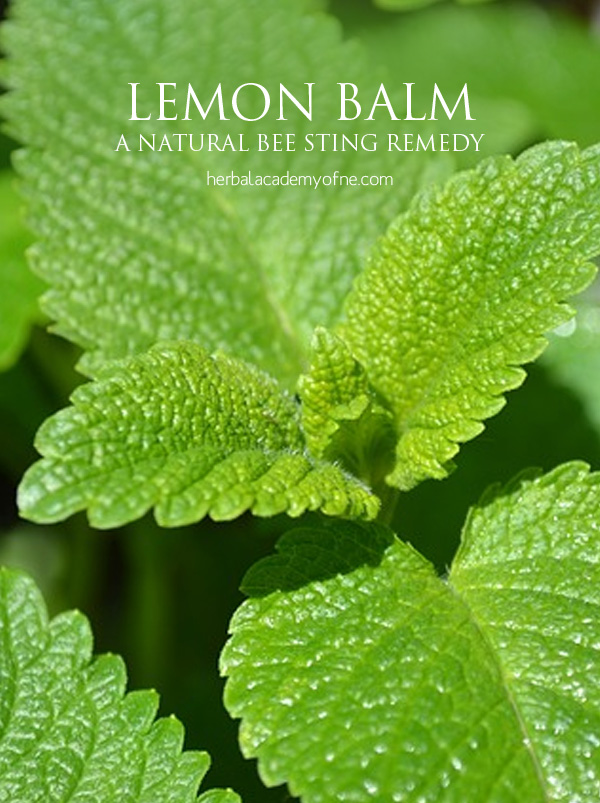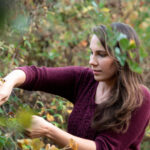
How To Use Lemon Balm As A Natural Bee Sting Remedy
When it comes to natural bee sting remedies, what herbs do you think of? I’m sure there are many, but the first one I’ve always thought of right off the bat is plantain…until recently that is.
Plantain is a great natural bee sting remedy, but I recently learned about lemon balm and its amazing ability to calm and comfort bug bites, including bee stings.
Although you may have your favorite natural bee sting remedy already, it never hurts to have another on standby. And you never know, maybe you’ll end up with a new favorite.

Today I want to tell you a bit about lemon balm as well as how to use it if you or your little ones end up with any stings this year.
What’s In A Name?
Lemon balm is mostly recognized as an herb for relaxing and calming the mind and body and is classified as a relaxing nervine. Many times it’s referred to simply as “balm” because of its calming, soothing, comforting properties.
How does this have anything to do with bee stings? Well, it all starts with the name.
The genus name of lemon balm is Melissa officinalis. “Melissa” originates from Greek and means “honey bee.” Lemon balm is a favorite plant of bees as it produces fragrant nectar, and it just so happens that bee keepers also use this plant, not only to provide nectar for their bees, but to calm and relax them in order to keep them from swarming and stinging.
So just by looking at this plants name, we can learn that it is a soothing plant linked with bees.
A Glimpse At Energetics
Lemon balm is one of those herbs that can be hard to categorize energetically. It’s a part of the mint family and as far as the temperature felt from this plant goes, it seems to be both warming and cooling as mints tend to have a cooling spice to them. When it comes to determining whether it’s moist or dry, herbalists have classified it as both. Isn’t that confusing?
It seems that each herbal tradition has its own views. In Ayruveda, lemon balm is classified as having hot and wet energetics; in Traditional Chinese Medicine it’s considered cooling and moistening; and in Western Herbalism it’s cooling and drying. One thing most herbalists do agree on though is that lemon balm is slightly bitter (and yet simultaneously sweet!) which lends itself well to using it with bee stings since most bitter herbs have great astringent properties.
So what does all this say to me as an herbalist who is new to learning about herbal energetics? I think this is a great herb to use in many different ways, and it acts differently depending upon its use. For bee stings, I find it cooling and drying as it soothes the pain of the sting and it has astringent properties to tighten and tone the tissues which, in this case, makes it drying.

Actions on Bee Stings
When using lemon balm on stings, the actions of the herb are mainly astringent. This helps to decrease the swelling of the sting site which in turn, decreases pain.
In almost all the research I did on using lemon balm as a natural bee sting remedy, fresh lemon balm was a must. The reason is because, like our food, fresh means something is more alive, and its chemicals are more active.
Lemon balm is a perennial plant that is easy to grow and likes partial shade so it’s a great idea to make this herb a welcome addition in your herb garden this year.
Using Lemon Balm With Bee Stings
When it comes to taking action and using this plant on your next bee sting, you have a couple different options. I’ll list each below in order of how effective I think they are.
Fresh Lemon Balm Poultice
To use lemon balm on a bee sting, simply pinch off a couple leaves from your plant and either smash and roll them between your fingers to release the juices or put them in your mouth and chew them (called a spit poultice) before placing them on the sting site.
It’s a good idea to place something over this poultice like a snug-fitting bandage to hold it on. Leave this on for 30 minutes before removing it. If the swelling hasn’t gone down enough or the sting site still hurts, you can repeat the process again.
Note: You can use make a poultice using dried lemon balm although I doubt it will be as effective as using fresh, but it’s worth a shot!
Dried Lemon Balm Astringent
This next natural bee sting remedy is a great way to help decrease the swelling of stings as it uses two herbs with astringent properties–lemon balm and witch hazel. Simply infuse 1 part dried lemon balm into 2 parts witch hazel distillate for two weeks to create a strong astringent toner that can be used on stings.
Put some of this astringent on a cotton ball and put that on the sting site. Hold it down using a band-aid or snug-fitting bandage, and repeat as needed.
In Conclusion
Lemon balm is one of those must-have herbs to have on hand. It’s great to grow in your herb garden, to have dried in your herb closet, and to have herbal preparations pre-made and on hand for when you need them. It has MANY different uses and can be used for all ages. Thankfully one of its most effective uses is as a natural bee sting remedy.
Have you used lemon balm as a natural bee sting remedy before? If so, what did you think? Was it effective for you?
Meagan Visser is a registered nurse turned home-schooling, stay-at-home mom to 4 small boys. She live in the Southern Appalachian Mountains of East Tennessee, and is currently a family herbalist that is passionate about using herbs for health and healing. She teaches natural-minded mamas how to take charge of their children’s health naturally on her blog GrowingUpHerbal.com and in her Letters To Natural Mamas emails.








